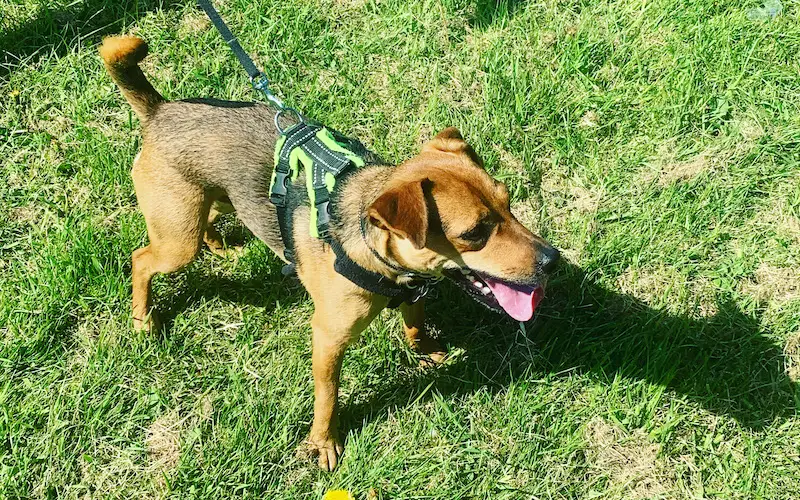If you have a stressed or reactive dog, you may have heard trainers talk about ‘trigger stacking’. This is a term used in canine psychology to identify what will push them ‘over the threshold’. If you learn how to manage your dog’s triggers this can also have a positive effect on his behaviour and well being.
Which Dog Owners need to understand `Trigger Stacking?
Dog owners may need to learn that trigger stacking may be relevant to their very anxious and stressed dogs. Also, owners of reactive dogs – perhaps rescue dogs from an abusive background and also maybe dogs who have just never been socialised or exposed as a pup or young adult. Dos with these issues tend to be very ‘reactive’ dogs – especially on lead when they cannot express their ‘fight or flight’ natural protective behaviours.
Our Reactive Patterdale Terrier
Our Patterdale terrier cross Blake shows some leash reactivity, particularly towards other dogs and fast moving objects such as bikes or scooters. We appointed a 121 trainer to help him. It was difficult to resolve these issues in a dog training class because having so many dogs around was stressful. Also there were no bikes at dog training, and so it was hard for him to get used to them if they are not there! We don’t like Blake to be under stress or for walkies to be stressful for ourselves. So we are working hard to understand his triggers in order to help him.

What is Trigger Stacking?
So image that you have a phobia such as spiders, they might have a bad start to the day (perhaps you stub your toe when you get out of bed!). Then you might see a small spider that is far away and someone else gets rid of it. Then you might see another one crawls across the kitchen. Then on seeing a third spider – potentially a big and horrible one, this might set off a full scale panic attack. That’s because the previous ‘trggers’ – the other spiders and negative experiences were ‘stacking up’. The last one is the final trigger that just simply ‘pushes you over the edge’.
Trigger Stacking in Dogs
Now, let’s transfer this to dogs. Imagine a dog who is scared to death of bikes and scooters. First of all, he is on a leash. So he cannot get away from the scary thing – his natural defence mechanisms are. taken away. This means that the walk starts with him feeling under threat. He may see a small child on a small child on a slow scooter in the next street. The he sees an electric scooter whizz past. The third thing that he sees is a bike – with a big scary man on it cycling top speed. This pushes him over the edge. His anxiety is through the roof and as a result his behaviour is out of control. No amount of treats, praise, or anything really will help at this point.

Going over the Threshold
This is the point at which the dog has completely gone ‘over the threshold’. AKA – completely lost it! Once a dog has gone over the threshold the likelihood is that he cannot concentrate on any training or positive reinforcement at that point – he is too far gone! His mental state won’t handle any training – he is not in the right mindset to receive it. He cannot enjoy the rest of the walk. And so the best thing to do if your dog has gone over the threshold is to just take him home. Allow him time to rest and get the cortisol (stress hormone) out of his body. This could take up to 72 hours!
Try again when he is calm
Once he is calm enough you can try again with training and walkies. BUT you need him to focus on you and not the trigger, so go armed with lots of high value dog treats and plenty of positive reinforcement training techniques!
The importance of Positive Reinforcement Dog training
It’s sad to think that so many reactive dogs are actually feeling so stressed that they have the canine version of a panic attack once too much trigger stacking has occurred. This is why positive reinforcement dog training is so important – it builds their confidence and reassures them and hopefully eventually they will trust you so much that the anxiety will calm down and the out of control behaviour will calm down or even stop.
Clicker training and Marker Word
Some people use clicker training where the dog associates the sound of a clicker with a reward. But a clicker isn’t always practical (just another thing to have to hold in your hand!) and so sometimes owners and trainers choose to use a marker word e.g. yes or treat! The marker word can be anything you choose – as long as the dog associates it with the treat to follow. You can then use the marker word as a positive interruptor – for example, he sees the bike, you say the marker word and instead of focussing on the trigger he looks at you for the reward!
Summary of Trigger Stacking in Dogs
Overall, understanding your dogs triggers, trigger stacking and when he has gone over the threshold will help us to understand what sets off our dogs. This in turn allows us to identify their fears and therefore where to ficus their positive reinforcement training.
I hope that you enjoyed this article, but most importantly, I hope that this article helps you and your dog.

